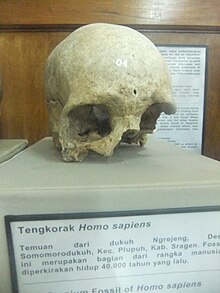| UNESCO World Heritage Site | |
|---|---|
 Replica of fossil from Sangiran ("Sangiran 17") | |
| Location | Indonesia |
| Criteria | Cultural: iii, vi |
| Reference | 593 |
| Inscription | 1996 (20th Session) |
| Area | 5,600 ha |
| Coordinates | 7°27′S 110°50′E / 7.450°S 110.833°E |
 | |

Sangiran is an archaeological excavation site in Java in Indonesia.[1] According to a UNESCO report (1995) "Sangiran is recognized by scientists to be one of the most important sites in the world for studying fossil man, ranking alongside Zhoukoudian (China), Willandra Lakes (Australia), Olduvai Gorge (Tanzania), and Sterkfontein (South Africa), and more fruitful in finds than any of these."[2]
The area comprises about 56 km2 (7 km x 8 km). It is located in Central Java, about 15 kilometers north of Surakarta in the Solo River valley. Administratively, Sangiran area is divided between 2 regencies: Sragen (districts of Gemolong, Kalijambe, and Plupuh) and Karanganyar (district of Gondangrejo). An important feature of the site is the geology of the area. Originally a dome was created millions of years ago through tectonic uplifts. The dome was then eroded exposing beds within the dome which are rich in archeological records.[3]
- ^ Choi, Kildo; Driwantoro, Dubel (2007). "Shell tool use by early members of Homo erectus in Sangiran, central Java, Indonesia: cut mark evidence". Journal of Archaeological Science. 34: 48. Bibcode:2007JArSc..34...48C. doi:10.1016/j.jas.2006.03.013.
- ^ World Heritage List note, Sangiran, No 593, September 1995.
- ^ Tantri Yuliandini, 'Tracing man's origins in Sangiran, Pacitan' Archived 2013-09-05 at the Wayback Machine, The Jakarta Post, 23 August 2002.
